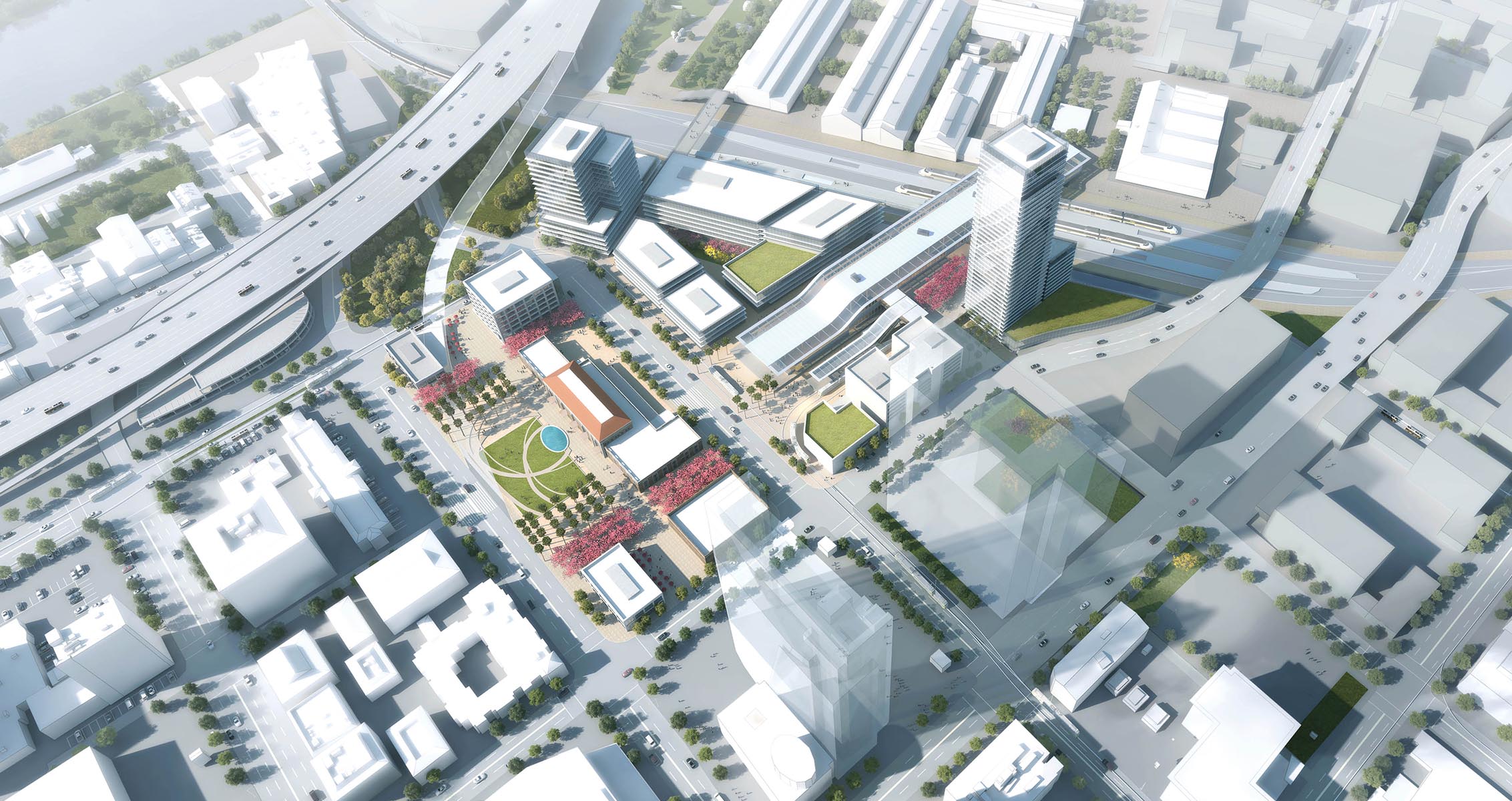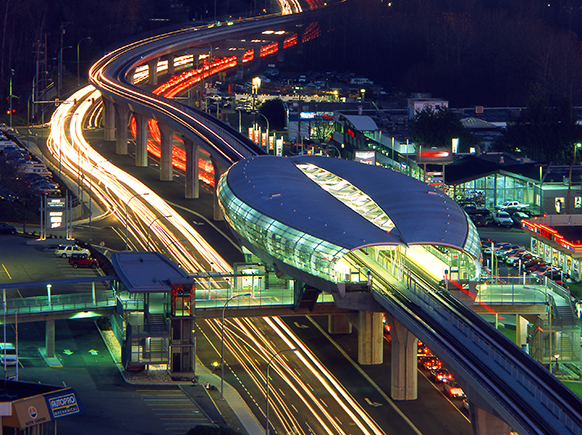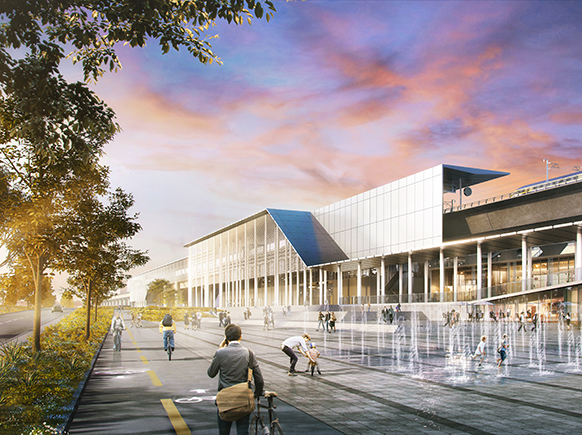In Europe, Asia and much of the developed world, high speed rail is convenient and accessible. Whether for business or pleasure, travelers are served by an efficient and extensive rail network that connects passengers to the desired destination on time and with relatively little effort. Although these train systems can travel as fast as 350 kilometers per hour, speed is not the only important factor. Rail stations in Europe, for example, are an integral part of the historic urban fabric. These facilities are often perceived as civic destinations that play a fundamental role in the mobility system, providing a wide range of services for the larger collective; shopping, entertainment, commercial, and civic uses are often paired with transit services as new stations are built and historic stations are retrofitted.
But as California and Texas embark on the development of high speed rail, how can urban planners and designers ensure the success of such systems in the US? When planning for high speed rail in the U.S., many of the local community members and stakeholder groups that we engage in our design process understand the efficiency, comfort and overall benefits of high speed rail especially as it functions in Europe.
However, the American landscape is quite different, and one recurring question we are asked is: “How do we make it work here?” While there are many lessons we can learn from Europe, the unique culture, history and physical attributes of U.S. cities require tailored strategies. Here are three to consider:
Establish a Destination
Before even designing the station, it is important to first plan for its context. While high speed rail stations all across Europe are, for the vast majority, at the heart of vibrant cities, in the U.S. this is rarely the case. The high cost of infrastructure and the impact on private properties often pushes stations towards the outskirts of downtown and in some cases at the edge of the city limits. Even when the station is located within downtown the lack of a supportive mix of uses and population densities frequently undermines the potential of rail interventions. Highly efficient, long-range rail connectivity is a critical asset and a catalyst for sustainable urban development that can positively contribute to local economic growth. High speed rail provides an opportunity to rethink the urban environment of many American cities as well as a chance to introduce new urban spaces that are centered on people, not cars.
The design for Perkins&Will’s Sacramento Valley Station aims to establish not only a functional and performing transit facility but a true gateway for the city as a whole. The new station area is designed to overcome the physical barriers surrounding the site such as the existing rail alignment to the north, the I-5 viaduct, and the 5th street overpass, and ultimately showcase the city’s culture and identity. By incorporating restaurants, art, and public gathering spaces into the design of the new station, we are able to overcome the physical barriers and bring people together.
A new system of open spaces and the extension of the existing street grids provide greater access to the site, the Old Sacramento historic district, the American River and trails. The proposed station layout acts as a bridge straddling the existing rail alignment connecting the historic Sacramento Valley Station to the Railyards Central Shops. A well programmed public realm and the strategic adaptive reuse of historic structures provide opportunities for community gatherings as restaurants, cafes, art galleries, farmers markets, etc. delivering a distinct sense of place that supports and celebrates the station as a new welcoming civic destination.
The master plan introduces a carefully balanced mix of uses such as jobs, housing, local and regional amenities that will leverage the proximity to transit and support a safe and engaging urban environment. This framework is instrumental in attracting new development both within and beyond the station area.
Attract an Audience
Today, U.S. rail services compete with other modes of transportation that Americans are much more accustomed to using. Cars and airplanes play an undisputed role in the American mobility system. In order to make existing and future rail services successful, it is important to not only ensure efficiency, but also make rail travel appealing.
As consumers are presented with the latest model, car commercials briefly describe specifications and performance; what they are really sold on is a distinctive experience. Similarly, when planning for high speed rail, experience must be at the center of the design process. Urban planners and designers are tasked with making sure that the journey from origin to destination is efficient, convenient, and most of all pleasant. In order to create a competitive transit service that can break into a car-dominated U.S. market, we must work to establish an appealing user experience that does not end at the station front door.
A cross-disciplinary approach is needed in order to deliver a project that successfully addresses each stage of the customer journey. This method leads to a design that blurs the lines between indoor and outdoor, letting elements such as mobility, public realm, active ground floor uses, identity, and wayfinding seamlessly extend into a continuous ground plane of activities serving the station and its surroundings. Setting clear experience design guidelines is a fundamental step towards achieving this goal and transit authorities, such as BART, are incorporating this approach more frequently.
Provide a Network
Ultimately, a rail station primarily requires strong mobility. As we step off the train in some of the most successful stations in Europe, we are immediately connected to a range of mobility options that will easily bring us to our final destination. High speed rail relies on the ability to effortlessly transition from regional to local transit, minimizing the need for private vehicles in order to cover the first and last segment of the journey. The lack of a mature local transit network and a prevailing car-centered culture are some of the main challenges of implementing rail infrastructure in the U.S. When planning for it, we need to ensure that all local transit services are integrated into the station area, minimizing conflicting options and prioritizing space-efficient modes of transportation such as walking and biking.
Today, the U.S. is at the epicenter of a mobility revolution. Transportation network technologies, such as Uber, Lyft, and other ride-sharing platforms are radically disrupting the way we move and, if well regulated, they have the potential to solve endemic challenges of many communities across America. With this in mind, high speed rail stations should be elevated to multimodal transit hubs, capable of serving a fast-changing mobility ecosystem. Stations in the U.S. can – and should – be new landmark destinations for commuters, visitors and local communities alike, placed at the core of successful, vibrant mixed-use urban environments that strategically leverage access to transit.
This article originally appeared in Arch Daily.


